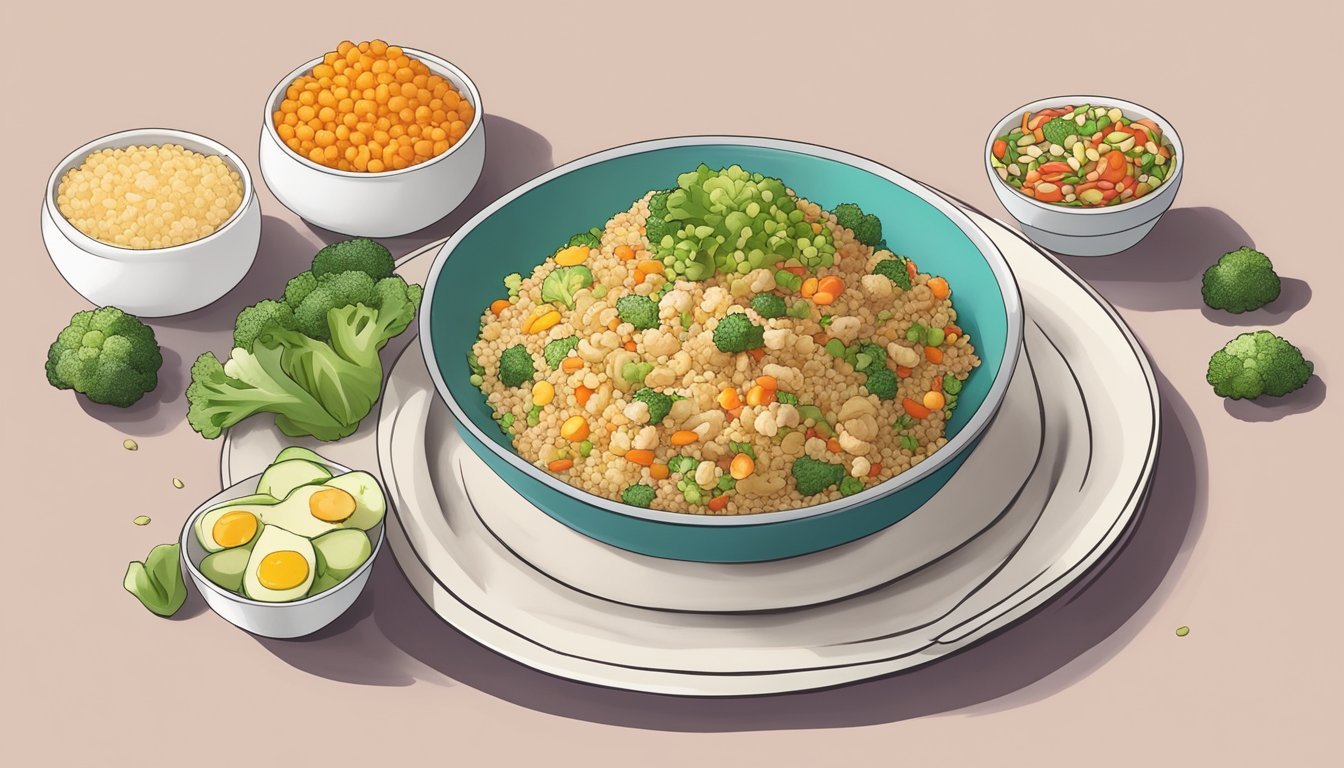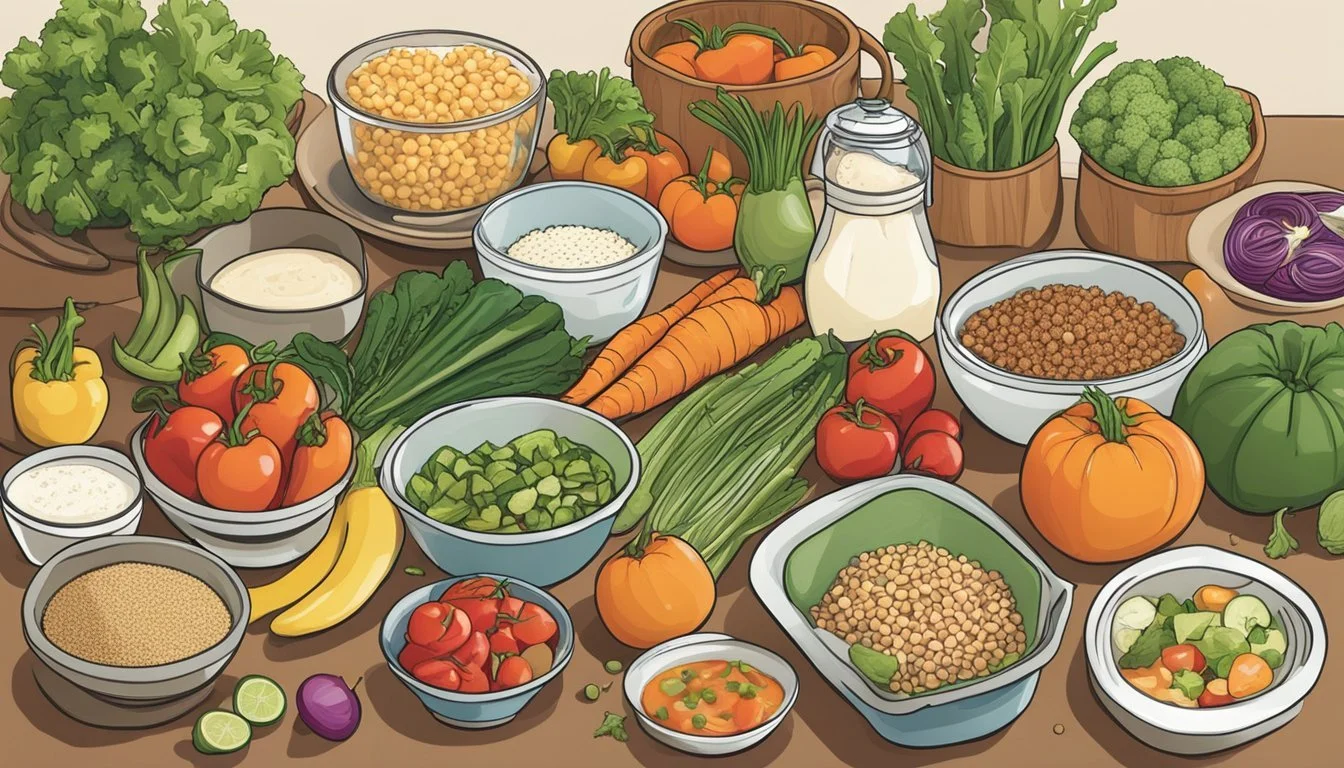11 Diabetes-Friendly Dinner Recipes You'll Love
Delicious And Nutritious Meals
Managing diabetes effectively requires careful attention to diet, and dinner can be a crucial meal for maintaining balanced blood sugar levels. This article brings you a collection of 11 diabetes-friendly dinner recipes that prioritize nutrition without sacrificing flavor, ensuring that you and your loved ones can enjoy wholesome meals together.
Seeking delicious, easy-to-prepare meals that are suitable for those with diabetes can sometimes be a challenge. These recipes focus on incorporating nutrient-dense ingredients, including lean proteins, whole grains, and an abundance of vegetables, to help manage diabetes while satisfying your taste buds.
1) Grilled Lemon Herb Chicken
Grilled Lemon Herb Chicken is a delicious and healthy option for dinner, especially for those managing diabetes. The dish features chicken marinated with a blend of lemon juice, olive oil, garlic, and herbes de Provence. These ingredients not only add flavor but also keep the meal light and nutritious.
The marinade, bursting with fresh lemon and herb flavors, is easy to prepare. Simply combine the ingredients in a plastic bag, add the chicken, and refrigerate for at least 30 minutes. This allows the flavors to fully penetrate the meat, resulting in juicy, flavorful chicken when grilled.
Cooking on a gas grill or over a medium-hot charcoal fire ensures the chicken is cooked through while retaining its moisture. Turn the chicken occasionally to achieve even cooking and a perfect char. This method also helps in reducing unhealthy fats, making it a heart-friendly choice.
For those without a grill, sautéing in a skillet is a practical alternative. Heat olive oil over medium-high heat and cook the chicken for about 10 minutes, flipping halfway. This method ensures the chicken remains tender and flavorful, with a slightly crispy exterior.
Pair the Grilled Lemon Herb Chicken with a side of vegetables or a light salad for a balanced meal.
2) Quinoa-Stuffed Bell Peppers
Quinoa-Stuffed Bell Peppers offer a nutritious and flavorful option for those managing diabetes. This dish combines cooked quinoa with black beans, colorful vegetables, and aromatic spices for a balanced meal.
To prepare, cut the tops off bell peppers and remove the core. Brush them lightly with oil and place them upright in a preheated oven at 375°F.
Fill each pepper with a mixture of quinoa, beans, and vegetables. The ingredients meld together to create a protein-rich and satisfying meal while keeping carbohydrates in check.
Place the stuffed peppers in a lightly greased baking dish. Bake for about 25-30 minutes, until the peppers are tender and the filling is heated through.
Serve hot, garnished with fresh herbs or a sprinkle of cheese, if desired. This diabetes-friendly recipe is sure to become a favorite in your healthy eating routine.
3) Zucchini Noodles with Pesto
Zucchini noodles, also known as zoodles, offer a low-carb alternative to traditional pasta, making them ideal for those managing diabetes. They are easy to prepare and pair perfectly with pesto, which adds a flavorful touch without raising blood sugar levels.
To start, spiralize fresh zucchinis to create the noodles. If spiralizing at home, a spiralizer tool can make the job quick and straightforward.
Heat olive oil in a large skillet over medium heat. Add the zucchini noodles and stir frequently. Cook for just a few minutes until they reach the desired texture. Avoid overcooking to keep them from becoming mushy.
Prepare the pesto using fresh basil, garlic, toasted nuts, and olive oil. A food processor yields a smooth consistency. Adjust seasoning with salt according to taste. For added flair, toss in some red pepper flakes.
Once the noodles are cooked, mix them with the prepared pesto. Make sure to coat them thoroughly for even flavor distribution. Optionally, add cherry tomatoes for color and extra taste.
Serve the Zucchini Noodles with Pesto immediately. They're delicious both hot and at room temperature, catering to various preferences. This dish provides a healthy, diabetes-friendly meal option that doesn't compromise on taste.
4) Baked Salmon with Dill
Baked Salmon with Dill is an excellent choice for a diabetes-friendly dinner. This dish is low in carbohydrates and high in protein and healthy fats.
To prepare, start with fresh, skinless salmon fillets. Season them with olive oil, salt, and pepper. Arrange lemon slices on top for added flavor.
The highlight of this recipe is the dill sauce. Mix plain Greek yogurt, chopped fresh dill, lemon juice, and Dijon mustard. This combination provides a tangy and refreshing contrast to the rich salmon.
Place the seasoned salmon on a baking sheet lined with parchment paper. Bake at 425°F for about 12-15 minutes, depending on the thickness of the fillets.
Serve the baked salmon with a generous spoonful of the dill sauce. Pair it with roasted vegetables or a side of quinoa for a complete, balanced meal.
This dish aligns well with dietary recommendations for those managing diabetes without compromising taste. The Omega-3 fatty acids in salmon are beneficial for heart health, making this a nutritious dinner choice.
5) Cauliflower Fried Rice
Cauliflower fried rice offers a low-carb alternative to traditional rice dishes. Finely chopped cauliflower mimics the texture of rice while significantly reducing calories and carbohydrates. For convenience, pre-packaged "riced" cauliflower, available both fresh and frozen, can save time.
The dish can easily be tailored as a main course by adding protein like chicken breast, shrimp, or tofu.
Vegetables such as peas, carrots, garlic, and onions enhance the nutritional profile, providing essential vitamins and minerals.
Adding scrambled eggs to the dish boosts protein content. Cook them in a separate skillet until light and fluffy before mixing them in.
Cooking the dish involves stirring the "riced" cauliflower with your chosen vegetables and seasonings over medium heat until tender. Typical seasonings include soy sauce, garlic powder, and pepper.
For an extra touch of flavor, some recipes suggest adding crispy bacon bits or using butter to sauté the vegetables. This versatile dish can be customized to suit different tastes while remaining suitable for blood sugar management.
6) Tofu Stir Fry
Tofu stir fry is an excellent option for a diabetes-friendly dinner. It's packed with protein and can be easily customized with various vegetables.
Start by heating olive oil in a large nonstick skillet or wok over medium-high heat. Add cubed tofu and sauté until golden brown on all sides. This step ensures a firm, crispy texture for the tofu.
After the tofu is browned, add soy sauce and cook for an additional minute. This enhances the flavor of the tofu. Remove the tofu from the pan and set it aside.
Next, heat a bit more olive oil in the same skillet. Add your choice of vegetables, such as bell peppers, bok choy, or onions. Stir-fry the vegetables until they are tender yet still crisp.
Combine the tofu with the vegetables and stir well. You can also add a splash of the reserved marinade if you've marinated the tofu beforehand. Cook for a few more minutes to let the flavors meld together.
Serve the tofu stir fry hot, either on its own or over a bed of brown rice or quinoa. This dish is both satisfying and nourishing, making it a great addition to a diabetes-friendly meal plan.
7) Lentil Soup
Lentil soup is a nutritious and satisfying option for those managing diabetes. Packed with fiber and protein, lentils help regulate blood sugar levels. This makes it an excellent choice for a diabetes-friendly dinner.
Preparing lentil soup often involves simple ingredients. Common components include lentils, onions, carrots, garlic, and various herbs. These ingredients create a flavorful and healthy meal.
Cooking lentil soup can be done on the stove or using an Instant Pot. Both methods are straightforward. The result is a hearty dish that can be enjoyed throughout the week.
In addition to its nutritional benefits, lentil soup is versatile. It can be customized with different vegetables and seasonings. This allows for a variety of flavors, keeping meals interesting and enjoyable.
Lentil soup is also easy to prepare in larger batches, making it perfect for meal prepping. This ensures you have a convenient and healthy option ready to go on busy days.
Incorporating lentil soup into a diabetes-friendly diet provides a delicious way to maintain balanced blood sugar levels. This dish is a practical and wholesome addition to any dinner rotation.
8) Spaghetti Squash Primavera
Spaghetti Squash Primavera is a nutritious and delicious option for those managing their diabetes. This dish features the low-carb benefits of spaghetti squash, providing an excellent alternative to traditional pasta.
To prepare, start by baking the spaghetti squash until it becomes tender. This ensures a texture that mimics pasta, while keeping the meal low in carbohydrates.
The sauce includes a mix of shallots, garlic, and a variety of colorful vegetables such as carrots, zucchini, broccoli, and yellow peppers. These vegetables add fiber, vitamins, and minerals to the dish.
Using avocado oil for sautéing not only adds a rich flavor but also provides healthy fats. Seasoning with salt and pepper enhances the natural tastes of the vegetables.
Finish the dish with Pecorino Romano cheese, which offers a sharp, tangy taste. This ingredient not only enriches the flavor but also contributes to the protein content of the meal.
Spaghetti Squash Primavera combines the best of fresh vegetables and a pasta-like experience, making it an ideal choice for a diabetes-friendly dinner.
9) Turkey Meatballs with Zucchini Noodles
This dish combines lean turkey meatballs with the lightness of zucchini noodles for a hearty yet healthy meal option. Zucchini noodles, or "zoodles," are a fantastic low-carb substitute for traditional pasta, making them ideal for individuals managing diabetes.
Start by preheating the oven to 400 degrees F. Lightly oil a baking sheet or use nonstick spray. In a bowl, mix ground turkey with Panko, Parmesan, egg yolks, oregano, basil, parsley, and garlic powder. Season with salt and pepper.
Shape the turkey mixture into meatballs. Arrange them on the baking sheet and bake for 25-30 minutes or until fully cooked. The result is delicious, juicy meatballs that pair perfectly with zucchini noodles.
For the zucchini noodles, spiralize fresh zucchini. Sauté the zoodles in a pan with a bit of olive oil, garlic, and a pinch of salt. Cook for just a few minutes until tender but still crisp.
Combine the cooked meatballs with the zoodles. This dish provides a balanced meal rich in protein and low in carbohydrates. It's also gluten-free, making it suitable for various dietary needs.
10) Eggplant Parmesan
Eggplant Parmesan is a delicious, diabetes-friendly meal that swaps heavy breading and frying for healthier ingredients. The dish starts with roasted eggplant slices, which are then layered with fresh, flavorful pesto and melty mozzarella cheese.
A rich marinara sauce, made by simmering tomatoes, garlic, and basil, adds depth to the dish. This combination offers a lower-carb, nutritious alternative to traditional Eggplant Parmesan.
The recipe involves simple steps such as baking the seasoned eggplant and assembling the layers in a casserole dish. It’s perfect for those looking to maintain their blood sugar levels without compromising on taste or satisfaction.
Aside from being diabetic-friendly, this Eggplant Parmesan makes clever use of fresh, seasonal produce. Ingredients like tomatoes and basil elevate the dish both in flavor and nutritional value.
Whether you're a fan of Italian cuisine or simply seeking a healthier dinner option, this Eggplant Parmesan ticks all the right boxes for a balanced meal that’s both tasty and health-conscious.
11) Greek Salad with Grilled Chicken
Greek Salad with Grilled Chicken presents a harmonious blend of flavors and nutrients suitable for diabetes-friendly dinners.
This dish combines crisp lettuce, juicy tomatoes, and refreshing cucumbers with the rich taste of olives and the sharp bite of red onions. Greek feta cheese adds a tangy element, melding perfectly with the fresh vegetables.
Grilled chicken serves as the protein source, tender and seasoned with Mediterranean herbs. The chicken can be marinated in a mixture of yogurt, olive oil, lemon juice, garlic, and spices for up to 24 hours, infusing it with robust flavors.
Once marinated, the chicken is grilled until golden brown and cooked through. After resting, it is sliced and added to the salad mixture. This ensures the meat remains juicy and retains maximum flavor.
The salad is dressed with a simple yet flavorful dressing made from vinegar, olive oil, mustard, oregano, and pepper. The dressing ties all the elements together, ensuring each bite is satisfying and nutritious.
This Greek Salad with Grilled Chicken makes a fresh, balanced meal perfect for those managing diabetes, offering both taste and health in one bowl.
Understanding Diabetes and Diet
Managing diabetes effectively hinges on understanding the impact of diet on blood sugar levels. Critical considerations include the role of carbohydrates and the importance of balancing macronutrients.
The Role of Carbohydrates
Carbohydrates have a significant impact on blood glucose levels. When consumed, they break down into glucose, which enters the bloodstream. It is crucial for individuals with diabetes to monitor their carb intake to maintain stable blood sugar levels.
Types of Carbohydrates:
Simple Carbs: Found in sugar, soda, and sweets
Complex Carbs: Present in whole grains, vegetables, and legumes
Complex carbs are preferred due to their slower digestion, resulting in a more gradual rise in blood sugar. Keeping track of carb intake and choosing high-fiber options is essential. Using tools like carb counting can assist in managing daily intake accurately.
Balancing Macronutrients
Balancing macronutrients—carbohydrates, proteins, and fats—is key in a diabetes-friendly diet. Each macronutrient affects blood sugar differently.
Carbohydrates: Should be monitored closely, focusing on whole grains, vegetables, and fruits. Portion control is important.
Proteins: Help in maintaining muscle mass and provide a feeling of fullness. Lean proteins such as chicken, fish, and plant-based options are preferred.
Fats: Healthy fats like those found in avocados, nuts, and olive oil help in reducing inflammation and support heart health.
Incorporating balanced meals with appropriate portions of each macronutrient helps in achieving stable blood sugar levels and overall better health management for people with diabetes.
Essential Ingredients for Diabetes-Friendly Meals
Choosing the right ingredients is crucial for managing diabetes. Incorporating low-glycemic vegetables, whole grains, and healthy fats can help maintain better blood sugar levels and promote overall health.
Low-Glycemic Vegetables
Low-glycemic vegetables have a minimal impact on blood sugar, making them excellent choices for diabetes-friendly meals. These include leafy greens like spinach and kale, cruciferous vegetables such as broccoli and cauliflower, and root vegetables like carrots and beets.
They are rich in fiber, vitamins, and minerals. For instance, broccoli is a good source of vitamin C and is linked to reduced inflammation. Leafy greens, like spinach, provide iron and folate. These vegetables can be roasted, steamed, or sautéed for a versatile range of dishes.
Whole Grains
Whole grains are integral for maintaining stable blood sugar levels. Unlike refined grains, they are high in fiber, which slows down glucose absorption. Some excellent options include:
Quinoa: High in protein and a complete amino acid profile.
Brown rice: Rich in magnesium and antioxidants.
Oats: Contain beta-glucan, which helps in lowering cholesterol.
These grains can be used in various meals—from hearty salads to filling side dishes—offering both texture and nutritional benefits.
Healthy Fats
Healthy fats play a crucial role in a diabetes-friendly diet. They help improve cholesterol levels and support heart health. Sources of healthy fats include:
Avocados: Packed with monounsaturated fats that promote good cholesterol.
Nuts and seeds: Provide omega-3 fatty acids and fiber.
Olive oil: Rich in antioxidants and reduces inflammation.
These can be incorporated into meals for added flavor and health benefits. For instance, a drizzle of olive oil can enhance a vegetable dish, while nuts can be a nutritious addition to salads.






